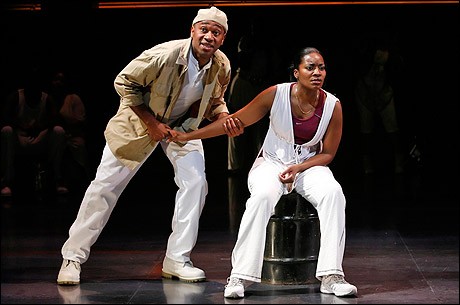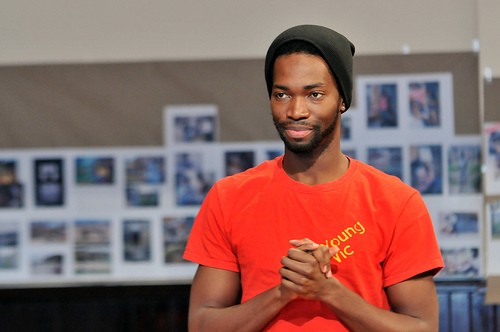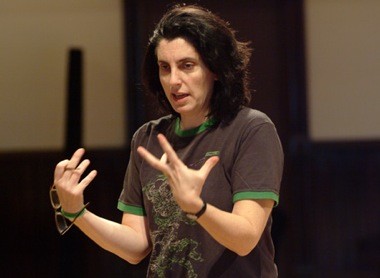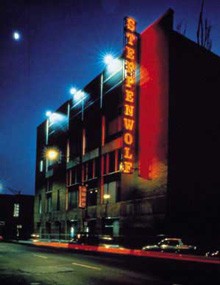The Brother - Sister Plays at Steppenwolf
Tarell Alvin McCraney Wows Chicago
By: Susan Hall - Feb 09, 2010
The Brother/Sister PlaysBy Tarell Alvin McCraney
Upstairs at the Steppenwolf
Through May 23, 2010
Directed by Tine Landau
Featuring ensemble members Alana Arenas, K. Todd Freeman, Ora Jones with Philip James Brannon, Rodrick Covington, Glenn Davis, Jeff Parker, Tamberla Perry, Jacqueline Williams.
Scenic and Costume Design: James Schuette, Lighting Design: Scott Zelinski; Sound Design, Michael Bodeen, Rob Milburn
Musical Supervisor: Zane Mark
For tickets call 312-335-1650 or
Steppenwolf Theatre Company
What a powerful pleasure Steppenwolf packs in the Brother/Sisters Plays by Tarell Alvin McCraney presented in Chicago at Upstairs at the Steppenwolf through May 23.
The ensemble cast is wonderful. Jacqueline Williams gets to do 'over-the-top' so by the very nature of her roles, she's a stand out. But gosh, she is so good at them.
K. Todd Freeman is the only actor who plays one role in all three plays, serving as a bridge between the generations. There is power in that singularity. He also brings a robust complexity to the square center of the play, a man who both loves and works.
McCraney talks about the plays being in the 'distant present.' This is different from T.S.Eliot's time, where "time present and time past are both perhaps present in time futureÂ…if all time is eternally present, All time is unredeemable."
In McCraney's 'distant present' we dive off the stage, and jump into a dream. He provokes, prompting leaps into past images and thoughts. Instantly in the first play, In the Red and Brown Water, I imagined Uncle Tom's Cabin. Watching the young central character, Oya, prepare for a track meet, the community comments on her running. In my mind's eye, Eliza runs across the river to freedom, leaving her captor behind as the ice breaks up.
The stage, primordial as it may be, dressed in a mottled grey sea wall and floor, called to mind the painting by Eastman Johnson, "Negro Life in the South," where work has been put aside in a back courtyard, and children play games, books are read, a dog waits to pounce and a young couple courts. Then too I conjured up Catfish Row in Porgy and Bess foreshadowing Oya's rebuff of a good man who loves her, choosing instead the sexy, bad one. Expansive panoramas of African American life past are evoked.
"What might have been and what has been is always present." Eliot. But 'distant,' says McCraney. These mullings and musings are about as heavy duty as any thoughts about the plays, sucked up as we are in the music of McCraney's language, the actual music -- from drumbeats to Motown to hip hop. We are riveted by the dancing figures swaying, stomping, with even a fantastic shivering shimmy by Philip James Brannon.
McCraney takes inspiration wherever he finds it. Clearly, dance is important to him, and in anticipation of the second play, he was inspired by Alvin Ailey's Revelations in which three men are trying to find a place to hide.
In ensemble theater, "...you don't just scratch the surface," says McCraney. "You say, 'Yes, we do want to go in that direction. What else can we do that like.' "
McCraney: continues, "Tina (the director) and I have worked four or five times together. Ensemble you can go back to the well and the think tank. On the same-page-ness. Concerted effort. Everybody is taking a giant or even a small step forward.".
For his intimate collaborator, the director of all three plays, Tina Landau, this is all about connection with the audience in the here and now. "Connect, only connect," she says.
One device frequently and effectively used is the reading of the actor's stage direction prior to his character's remark. These two types of speech are delivered seamlessly, but the audience is well aware of the separation: the actor telling herself to smile, and then smiling. Some have interpreted this use of language as a way for the actor to step out of the role and come closer to the audience. I immediately bought into the device.
I remembered Overtones the 1915 play written after Freud's first visit to America, which had heightened interest in hidden thoughts and desires. Two actors played each character, one with the real world appearance; the other, a wild interior. In the Brother/Sister Plays, the 'stage direction' is not simply directive. In the voice of the actor, the character's attidude toward the action or phrase is clear. This adds a layer to the already densely layered plays and deepens the experience. I was taken in, not taken out by an actor separating from his role, but by the double take.
These are after thoughts. In the middle of it all, I was swept up by the emotion, in caring for the lives of these people, sadness over past difficulties, and fears, precipitated by their dreams of disaster. Even Dr. Pangloss of Voltaire's Candide would not say this is the best of all possible worlds. A world that yields up hurricanes that strip you of everything.
The raucous humor of the plays is not conveyed in of outline, but language is often bright and playful repartee. It is funny like Chris Rock in small bites.
The truths of the play are the individual truths of the characters. To understand a person or a situation, everything is brought into play -- religion, spirituality, music, dance. While this is done from an individual perspective -postmodern is a term often used to describe McCraney's work- we have also the presence of a larger frame in inevitably violent nature and war hovering in the background. War is referred to as 'incidents' and the audience cracked up. These plays are about everyman.
In Red and Brown Water is formal, lyrical and filled with the beats and gestures of dance. The Brothers Size is tougher and more bare. We enter a dream world in Marcus as a young man struggles with his sexual identity in a community that doesn't easily accept difference. The plays are performed on separate nights, and structured so they can be seen in any order. Marathons comprised of all three plays are offered on weekends. Whatever your choice, all three plays are a must-see.





